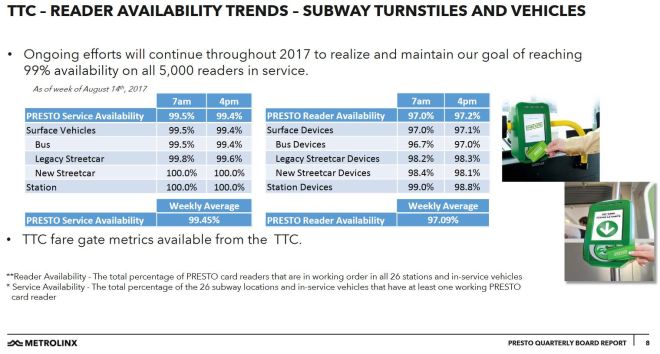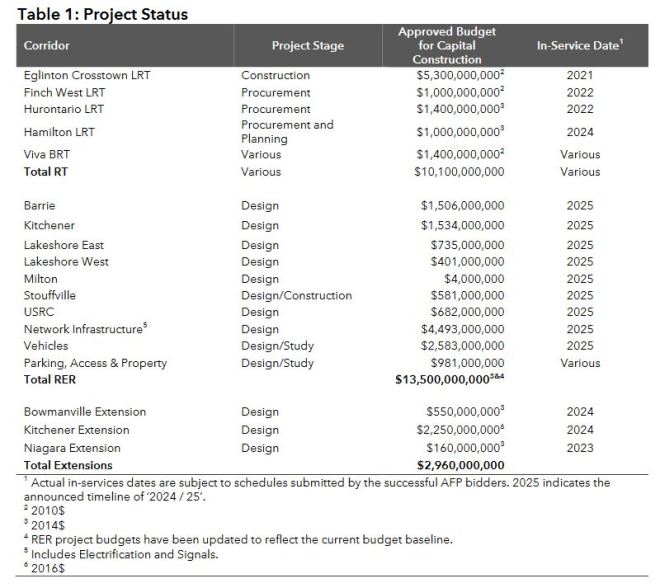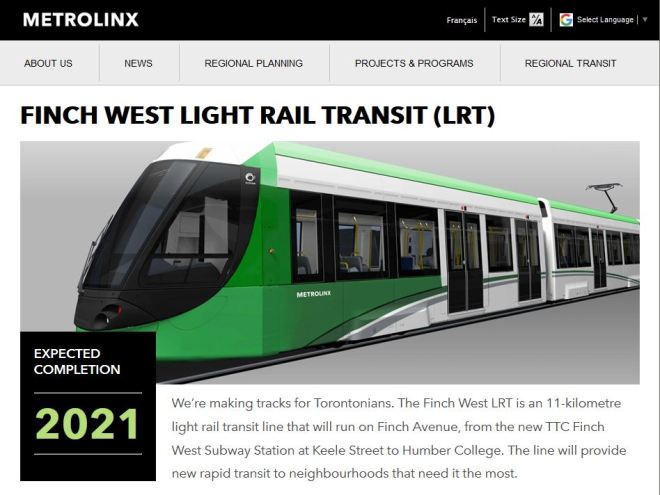Updated September 14, 2017 at 6:00 pm: An inconsistency in the opening date for the Finch West LRT between the Capital projects update and the project’s website has been flagged by a reader. Snapshots have been added to this article.
The Metrolinx Board met on September 14 to consider various reports. I have already written about the Fare Integration update, and will devote separate article(s) to the “Next Big Move”, the updated regional plan.
Other items of interest on the agenda included:
Presto Update and Quarterly Report
The roll out of Presto continues and TTC, even with a relatively low take-up rate to date, now accounts for more Presto taps than any other agency in the network. However, this only slightly more than one quarter of all Presto “taps” on a monthly basis (6.6 million for TTC vs about 24m for all systems). As the proportion of Presto-based TTC trips rises, TTC figures will dwarf all other agencies.
Status updates of note:
- Readers are now performing well, but problems remain with the add value machines. A new generation of machines is now in testing and these will be rolled out across the system in the near future, including on the about-to-open Spadina subway extension to Vaughan.
- There is no plan to introduce “open payments” (credit/debit cards, etc) on Presto in 2018 because Metrolinx is pre-occupied with the TTC roll out. Something might appear in the following year, but a related issue is that security standards for bank card transactions keep changing and getting tighter requiring ongoing design updates.
- Presto sales and reload functions in Shoppers Drug Mart stores have been well received.
- Presto supports “UPASS” programs. These are specific to each institution, not a system-wide standard implementation. Improvements coming in November:
- UPASS program core functionalities enabled as part of PRESTO Vouchers solution.
- UPASS program will provide discounted fares to university students in their respective districts through their local transit agency and universities.
- Students will be able to electronically load discounted passes onto their cards through the PRESTO Customer Website, and universities can add eligible students through the PRESTO Vouchers portal.
- Presto has negotiated a new agreement with various client agencies. There was no information in the presentation about how willing these agencies/cities were to accept higher service fees to fund the Presto system.
- Presto is developing a new privacy policy for disclosure of data to law enforcement agencies. Public feedback on their proposals will be sought through a web survey, stakeholder groups and public sessions. The Information and Privacy Commissioner will review management proposals to ensure that they comply with applicable laws. A proposed policy update will come to the Board in December 2017.

Capital Projects Update and Quarterly Report
Metrolinx’ large inventory of capital projects continues, notably the Crosstown LRT, but also expansion of GO corridors.
There was a lengthy discussion of Union Station capacity, and among the information that came out was that Metrolinx is considering a reconfiguration of the station with fewer tracks and wider platforms. This would provide more passenger handling capacity, a key requirement considering the anticipated rise in service on all corridors. A new layout would also imply that services would be “hooked up” east and west of Union rather than terminating there. This would considerably simplify operations. A study of Union’s future requirements will come to the Board in December 2017.
Metrolinx is planning to study the status and appropriateness of Hydrogen technology to their operations:
- A feasibility study on the use of hydrogen fuel cells as an alternative technology for electrifying GO rail service and the UP Express is underway
- Ontario is committed to running electrified trains on the GO rail network by 2025. Studying the feasibility of hydrogen rail technology is part of our due diligence to ensure that we choose the appropriate technology.
- Metrolinx has had discussions with the Germany-based National Organization Hydrogen and Fuel Cell Technology (NOW) to learn directly about early experience
- Metrolinx is committed to bringing industry leaders together for a symposium later this year to explore the potential application of hydrogen fuel cell technology
This will be useful if only to get a current view of the technology’s maturity and applicability, assuming that there are no Ministerial interests in forcing a conversion on Metrolinx. According to staff, they are operating on the basis that RER will be rolled out with existing electrification technology.
Updated September 14, 2017 at 6:00 pm:
In the Quarterly Report, there is a status table for all of the projects. The Finch West LRT is shown with an In-Service date of 2022.

However, the project’s web page shows a 2021 opening. I have asked Metrolinx to clarify this discrepancy. Thanks to reader Kass Forman for catching this.

The Annual Report includes, under the heading of “Being responsive & accountable”, the following statement [p. vii]:
Metrolinx is:
- Increasing transparency in its financial, labour, realty, freedom of information, support fleet, information technology and capital projects details, so that Corporate and Administrative Costs are easier to understand.
- Increasingly relying on evidence-based cost drivers to strengthen the data used to allocate costs to capital and operating programs.
These are fascinating claims considering the degree to which Metrolinx is a secretive organization. Far too many background studies are published, if at all, long after the Board has made a decision and the time for public input which could have been informed by such studies has passed.
“Freedom of Information” should occur naturally (as it would for a municipal agency), not when it is forced on Metrolinx by a formal FOI request from the media.
Easy understanding of costs will be more challenging because of corporate restructuring to amalgamate former divisions (Presto and UPX) into the main body of Metrolinx.
The integration and consolidation of operations under one management structure will deliver core Metrolinx services to customers and allow us to leverage internal learning and skills so we can adapt quickly and respond to our dynamic and fast-changing region. While we will maintain the identities of each service brand externally, we will be looking for opportunities to help our customers and the public understand the connections between each service and product. Beginning next fiscal year, we will report on our consolidated transit operations division, which will combine data and statistics for GO Transit and UP Express. [p. viii]
This will make determination of the profitability or cost of individual segments that have been treated as independent divisions more difficult, along with the degree of cross-subsidy that might exist between various aspects of Metrolinx’ businesses.
I asked Robert Siddall about this during the press scrum after the meeting. Siddall is the Metrolinx CFO, but is also Acting President and CEO pending the arrival of a recently-appointed CEO in October. He replied that with UPX becoming operationally part of GO Transit, it did not make sense to attempt to break it out as a separate cost and revenue centre. He was silent on the question of Presto.
For 2016-17, Presto received $14.8 million in usage fees. Operating costs were not broken out. [See charts on pp 35 and 38 of the report.] Oddly, the Presto update earlier in the agenda treated the negotiation of the client agreement with UPX as if this were a completely separate agency rather than part of GO Transit. The degree to which there are cross-subsidies between GO and UPX trips and Presto is completely hidden.
To Kirby, or Not To Kirby
The line in the Annual Report about “evidence-based cost drivers” is particularly amusing given the situation at both the provincial and municipal levels.
Ben Spurr in the Star has reported on political interference with the stations selected to be part of GO’s coming expansion. Specifically, the Lawrence East and Kirby Stations were originally not to be included in the list recommended to the Metrolinx Board, but this changed after intervention by the Minister of Transportation.
During the press scrum, Metrolinx Chair Rob Prichard performed a not-too-elegant dance around repeated questions about just how the change in Metrolinx’ official position on these stations came about. Boiling many answers down to their core, he argued that although the Board had considered the matter of the station list on three occasions, they only actually voted on it once. Moreover, it is Metrolinx’ job, he argued, to provide advice based on information and analyses they have. Such decisions are a combination of technical analysis and art, he said. It was a performance not quite at the level of Swan Lake. [I will leave it to the reader to decide whether Prichard was auditioning for Prince Siegfried or Baron von Rothbart.]
An obvious question here is this: Metrolinx is supposed to give advice based on their expert technical studies (and whatever art they might muster). However, if the Cities of Toronto and Vaughan have new information about development plans for these two station sites, one must ask why Metrolinx staff and consultants did not have this as part of their study. How credible is any plan Metrolinx produces if “new information” can arise with clear political motives to swing decisions?
Fare Integration Update
As I previously reported, Metrolinx has rethought its approach to integration so that it can actually achieve something rather than endless discussion. Specifically, the Board approved:
- The Metrolinx Board endorse the step-by-step strategy outlined in the Report and that staff report back on December 14th 2017 on means to advance the strategy which includes:
- Discounts on double fares (GO-TTC)
- Discounts on double fares (905-TTC)
- Adjustments to GO’s fare structure
- Fare Policy Harmonization
- Staff undertake to engage the public and key stakeholders (including municipal elected officials) on advancing the step-by-step strategy
- Staff post the consultant’s Draft GTHA Fare Structure Preliminary Business Case
After a long period when Metrolinx was attempting a “big bang” change in fare policy, they are now trying a “step-by-step” approach intended to deal with the most annoying inconsistencies in regional policy without actually tearing the entire structure apart. Although it is clear Metrolinx would like to reach an end-state based on fare-by-distance, they will settle for an interim configuration for “two to five years”, according to Leslie Woo, Chief Planning Officer. Politically, that is equivalent to saying that the matter is deferred sine die.
This would conveniently allow someone in, say, the midst of an election campaign, to promise added funding to cover the cost of bringing the TTC into a consolidated fare system, to rationalize GO transit’s fares, and to sort out some regional inconsistencies such as the TTC’s transfer policies.
If Toronto adopted the two-hour transfer, this would make a seamless cross-border trip simple to implement and administer for Presto users. With the 416/905 barrier out of the way, the “need” to completely reorganize fares would drop substantially, and the political leverage to go “all the way” to fare-by-distance would be reduced almost to vanishing.
One issue came up during the scrum, and it will be thrown into the hopper for December’s report: the integration of UPX fares with the rest of GO. It makes no sense to operate UPX effectively as a short turn service on the Kitchener line while charging different fares. Moreover, integration of UPX trips with the wider GO tariff, including any TTC co-fare, is essential if Metrolinx is to play by the same rules they expect of every other transit agency.
Particularly important to any discussion about alternative fare schemes will be an open revelation of how each arrangement would affect different types of riders. Metrolinx has always been silent on the effect of a distance-based fare and premiums for “rapid transit” (e.g. subway) on long-haul suburban commuters within Toronto. Failure to publish this information puts the “debate” in the ludicrous situation of asking for a faith-based approval rather than one based on actual evidence. This kind of “planning” and “consultation” at Metrolinx must stop if they are to achieve their goals for transparency.

I may be missing something but from the GO and UPX ticket sites the cost of a standard one way ticket from Union to Bloor is $5.30 on either GO or UPX. (of course, there are many systems – Vancouver and San Francisco come to mind – where a ticket from or to the airport station is more expensive than the zone or distance would warrant. Much more than to or from the last station BEFORE the airport.)
Steve: The question came up of whether a through trip via UPX+GO to a location other than Union would charge the same fare as GO all the way. There are mixed reports of what happens.
LikeLike
Has anyone noticed that the in-service date for the Finch West LRT has slipped back one year to 2022 ?
This may have been inevitable for sometime, but this is the first capital project report to actually show a date other than 2021, and by extension the first admission of this by MetroLinx.
Steve: I have sent Metrolinx a query about this but don’t expect to hear until tomorrow (Friday). Thanks for catching this. I will update the article to flag it.
LikeLiked by 1 person
Great summary, Steve… as always, exemplary, insightful commentary!
Steve: Thank you!
LikeLike
For a long time Metrolinx kept saying that fare integration would be revenue neutral. Practically (and politically) I never saw how that could be possible. It sounds like they’re softening on that position. Do you agree?
Steve: Yes, and we have wasted a lot of time getting to this point.
LikeLike
The Finch West LRT could be finished by 2021. However, the light rail vehicles will not be available until the very end of 2022. lol.
LikeLiked by 1 person
I love Prichard’s statement that the way Metrolinx makes decisions on stations is both based on science and art. The only art I see is how to bury the scientific facts under male bovine excrement without have the smell stick.
You may like Swan Lake but I am remind of the song in the Best Little Whore House in Texas where Charles Durning sings “The Sidestep”.
LikeLike
The possibility of integrating UP Express fares with the GO system is interesting especially as it might somehow be tied to a UP Express extension to East Harbour that might be presented as part of a pitch to Amazon for HQ2.
But with the known plan for a UP Express station at Mount Dennis, and the possibility of a station at Woodbine (despite the stories of trains conking out while attempting to climb the spur to Pearson), I really wonder what the future of UP Express is going to be once RER or frequent daytime service is introduced to the Kitchener corridor.
UP Express is becoming much more like a GO line with small trains than a direct express train, and now is limited by its own infrastructure. It’s a nice stopgap to have trains serving Bloor & Weston every 15 minutes, serving as a sort of infrequent DRL, but how necessary will it be to offer this type of service when GO trains are also running at 15 minute frequencies.
Does UP Express eventually become SmartTrack, helping address the credibility faced by both?
On the topic of fare integration, I would like to see the expansion of the current GO-TTC sticker zone to include Bloor Station today, with other stations (Mimico, Long Branch, Weston, Kennedy) included in the near future, once daytime service on the Stouffville & Kitchener lines see improved frequencies. This would be a good temporary stopgap while Metrolinx addresses the issue of short distance GO trips.
And personally, as a resident of Mississauga I would love to see better harmonization of fares as soon as possible. Right now it costs me almost as much to take MiWay+TTC (at full fares) from my home to downtown Toronto than it does for me to take MiWay (with Co-Fare) and GO. The irony is that both trips take around the same travel time and waiting time.
My current afternoon peak “trick” is to take the Milton Line train from Union to Kipling then walk to catch a MiWay bus using the Co-Fare. It takes a little more time but costs less than taking GO to Cooksville or Erindale. I’ll be much more likely to do this when MiWay moves to Kipling Station.
LikeLike
I asked Greg Percy about the 16 locomotives outstanding on the MPI order. He said that the first is under production but is being delayed by a part back order. It will feature a high rpm Cummins diesel and have AC traction motors. This is probably the QSK95 engine which is going into the new Siemens Charger locomotives. They are capable of 4400 hp.
LikeLike
It is interesting that it has taken so long to implement UPass functionality in PRESTO. All of the post-secondary schools in Ottawa have switched to contactless cards as OCTranspo prepares to phase in its new faregates. The cards work on the existing Presto readers, however they have been implemented using STO’s Multi Farecard. It seems Ottawa is staying as far from Presto as possible.
LikeLike
I’ve been rather busy lately, but just wanted to share this: A page for public comment on the 2041 RTP.
LikeLike